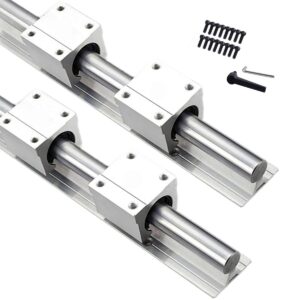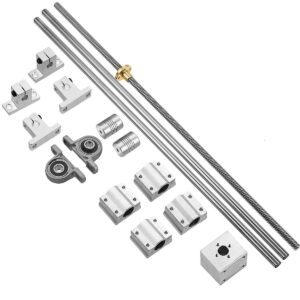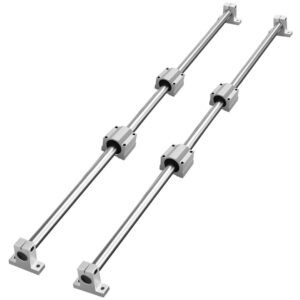Outline for the Article on “Linear Carriage”
| Main Topic | Sub-Topics |
|---|---|
| Introduction to Linear Carriage | What is a linear carriage?, Historical development, Importance in modern industries |
| Linear Carriage Fundamentals | Core components, How linear carriages work, Types of motion supported |
| Types of Linear Carriages | Ball-type linear carriage, Roller-type carriage, Plain bearing carriage, Hybrid linear carriage |
| Materials Used in Linear Carriages | Stainless steel, Aluminum, Polymer composites, Ceramic coatings |
| Linear Carriage and Guide Rails | Relation between guide rails and carriages, Types of guide rails, Choosing the right rail |
| Applications of Linear Carriage | CNC machines, 3D printers, Robotics, Medical equipment, Automotive manufacturing |
| Benefits of Linear Carriages | Precision and accuracy, Durability, Low friction, Load handling |
| Limitations of Linear Carriages | Wear and tear, Environmental limitations, Cost factors |
| Installation of Linear Carriage | Tools needed, Step-by-step installation, Common mistakes |
| Maintenance and Care | Cleaning techniques, Lubrication practices, Preventing misalignment |
| Innovations in Linear Carriage Design | Smart sensors integration, Lightweight designs, Anti-vibration features |
| Choosing the Right Linear Carriage | Load capacity considerations, Speed requirements, Accuracy levels, Budget planning |
| Troubleshooting Issues | Noisy carriage, Uneven movement, Excessive friction, Misalignment problems |
| Linear Carriage vs Other Systems | Comparison with rotary bearings, Comparison with pneumatic systems |
| Linear Carriage in Robotics | Enhancing precision, Load-bearing for robotic arms, Role in automation |
| Linear Carriage in Aerospace | Weight reduction needs, High-precision tolerance, Aerospace material use |
| Linear Carriage for DIY Projects | Maker projects, Home automation systems, Small CNC builds |
| Cost Factors in Linear Carriage Systems | Industrial pricing, DIY affordability, Cost-saving tips |
| Environmental Impact | Sustainable materials, Recycling options, Eco-friendly lubrication |
| Future of Linear Carriages | AI integration, Magnetic levitation, Predictive maintenance |
| Case Studies | Success in automotive, Use in medical technology, Aerospace achievements |
| Linear Carriage Standards and Certifications | ISO compliance, Industry standards, Safety considerations |
| Frequently Asked Questions | Addressing common doubts |
| Conclusion | Key takeaways, Importance of future-ready systems |
| Suggested Inbound & Outbound Links | Internal links, External references |
Introduction to Linear Carriage
A linear carriage is the unsung hero of modern engineering. Wherever precise, straight-line motion is required, linear carriages come into play. Imagine a CNC machine cutting a piece of metal with razor-sharp accuracy, or a 3D printer laying down plastic layers in perfect alignment. Behind these machines lies the quiet but essential motion control system powered by linear carriages.
Historically, linear motion was achieved using simple slides and grooves made from wood or metal. While functional, these systems suffered from friction, uneven wear, and limited load-handling capacity. With the rise of industrial automation, engineers demanded systems that could offer precision, longevity, and smooth movement under heavy loads. The answer was the modern linear carriage system—engineered with advanced bearings, lubricants, and guide rails.
In today’s world, linear carriages are used in robotics, aerospace technology, medical devices, automotive production, and even DIY maker projects. They enable seamless transitions, high-speed motion, and consistent accuracy in demanding environments. More than just moving parts, they represent the backbone of automation.

Linear Carriage Fundamentals
To appreciate the complexity of a linear carriage, it helps to break down its fundamentals. At its core, a linear carriage consists of:
Guide rails – The track along which the carriage moves.
Carriage block – The housing that slides or rolls along the rail.
Rolling elements – Ball bearings or rollers that minimize friction.
Lubrication system – Ensures smooth motion and reduces wear.
A linear carriage works by supporting a load while allowing it to move freely in one direction. Unlike rotary bearings, which handle circular motion, linear carriages are designed exclusively for straight-line precision. Their main advantage lies in reducing friction and improving the stability of the moving object.
The mechanics depend on the type of rolling element. Ball-bearing linear carriages use small balls that circulate in a raceway, offering low friction and high accuracy. Roller carriages, on the other hand, use cylindrical rollers, which handle heavier loads and provide rigidity.
These carriages not only support physical loads but also absorb vibration, resist misalignment, and ensure repeatability—a must in industries like aerospace and medical imaging, where the smallest deviation can have costly consequences.
Types of Linear Carriages
Different applications call for different linear carriage designs. Engineers choose the type depending on load requirements, precision needs, and environmental conditions.
Ball-type linear carriage
This is the most common type, using ball bearings that circulate within the block. It provides excellent precision, smooth motion, and low friction, making it ideal for CNC machines, 3D printers, and robotics.
Roller-type carriage
Instead of balls, these carriages use cylindrical rollers. The larger contact surface allows them to handle heavier loads with improved rigidity. They are preferred in heavy-duty machinery such as automotive assembly lines and aerospace manufacturing equipment.
Plain bearing carriage
Unlike the rolling types, plain bearings slide along the rail without rollers. These are simpler, cheaper, and suitable for applications where noise reduction and minimal maintenance are priorities, such as in medical devices.
Hybrid linear carriage
A combination of ball and roller elements, hybrid carriages are designed for specialized applications requiring both high precision and high load capacity. These are less common but increasingly relevant in advanced robotics and aerospace systems.
Each type brings its own strengths, and choosing the right one can significantly impact the performance and lifespan of a machine.
Materials Used in Linear Carriages
The choice of material in a linear carriage plays a pivotal role in its performance, longevity, and adaptability to different environments. Unlike many machine components where one or two materials dominate, linear carriages make use of a diverse range of materials, each tailored to suit specific applications.
Stainless Steel
Stainless steel is the most common material for linear carriages due to its durability, corrosion resistance, and strength. In industries where moisture, chemicals, or exposure to harsh environments is common, stainless steel ensures that the carriage doesn’t rust or degrade quickly. It’s widely used in medical equipment, food processing machinery, and marine applications.
Aluminum
Lightweight and versatile, aluminum is often chosen for carriages used in applications where reducing overall machine weight is critical. For instance, in aerospace or robotics, aluminum linear carriages help minimize inertia, making systems faster and more responsive. Additionally, aluminum’s natural oxide layer provides some protection against corrosion, though it may not withstand extreme conditions as well as stainless steel.
Polymer Composites
For applications requiring quiet operation, low maintenance, or chemical resistance, polymer-based linear carriages are gaining popularity. These materials are self-lubricating, reducing the need for constant oiling or greasing. They’re especially common in the medical and electronics industries, where cleanliness and noise reduction are crucial.
Ceramic Coatings
Though not a material in themselves, ceramic coatings applied to metal surfaces can enhance wear resistance and reduce friction. In environments where abrasive dust or chemicals could damage standard materials, ceramic-coated linear carriages provide extra resilience.
The choice between these materials is not always straightforward. For example, while stainless steel offers superior strength, it’s heavier than aluminum. Similarly, while polymers reduce noise, they may not handle high loads as effectively. Engineers must weigh these trade-offs carefully to match the right material to the task at hand.

Linear Carriage and Guide Rails
A linear carriage doesn’t work in isolation—it relies heavily on guide rails to provide stability, direction, and support. The relationship between the carriage and its rail is as important as the relationship between tires and a road. Without a precise, well-engineered rail, even the best linear carriage will underperform.
Types of Guide Rails
Profiled guide rails – These rails have precise grooves that allow the rolling elements inside the carriage to engage with accuracy. They provide high load capacity and stiffness, making them ideal for CNC and industrial machines.
Round guide rails – As the name suggests, these are cylindrical rods. While not as precise as profiled rails, they’re easier to install and are often used in applications where moderate precision is acceptable, such as packaging equipment or light automation systems.
Flat rails – Used in simpler sliding systems, flat rails are often paired with plain bearing carriages. They are cost-effective but limited in precision.
Choosing the Right Rail
Selecting the right rail depends on the load, speed, and accuracy requirements of the system. For instance, if a 3D printer needs to produce fine details with exact repeatability, profiled rails with ball-bearing carriages are preferred. Conversely, a warehouse automation system that prioritizes speed over micro-level accuracy may employ round rails with roller-type carriages.
The synergy between the linear carriage and guide rail determines the smoothness of motion, resistance to vibration, and overall machine performance. A mismatch can lead to premature wear, misalignment, and costly downtime.
Applications of Linear Carriage
The versatility of the linear carriage makes it indispensable across industries. Its ability to provide smooth, precise motion has revolutionized the way machines function. Let’s explore some of the most notable applications:
CNC Machines
Linear carriages are the backbone of CNC machining centers. They enable cutting tools to move with micron-level accuracy, ensuring parts are shaped exactly as programmed. Without them, industries like automotive and aerospace wouldn’t achieve their current precision levels.
3D Printers
In 3D printing, layer alignment is crucial. Linear carriages ensure the printer head moves consistently across the X, Y, and Z axes. A small misalignment can ruin an entire print, so carriages play a vital role in print quality.
Robotics
Robotic arms rely on linear carriages for repeatable and precise movement. Whether assembling tiny electronic components or welding car frames, carriages allow robots to perform tasks with speed and consistency.
Medical Equipment
Imaging machines like MRI scanners and surgical robots depend on linear motion systems to operate accurately. Here, carriages must be quiet, clean, and maintenance-free, making polymer-based systems particularly useful.
Automotive Manufacturing
From assembly lines to testing stations, linear carriages support automation at every step. They ensure accuracy in component alignment, reduce downtime, and withstand heavy-duty usage in demanding factory environments.
The adaptability of linear carriages makes them a critical building block for industries striving for greater efficiency, accuracy, and automation.
Benefits of Linear Carriages
The popularity of the linear carriage in engineering isn’t just a coincidence—it’s the direct result of its many advantages. These benefits make it an indispensable component for countless industries that rely on accuracy, reliability, and efficiency.
Precision and Accuracy
Linear carriages deliver motion with extremely tight tolerances. This precision is vital in sectors like aerospace and medical imaging, where even a fraction of a millimeter can make the difference between success and failure.
Durability and Long Life
When properly maintained, linear carriages last for years without significant performance loss. High-quality materials such as stainless steel and aluminum alloys resist wear and ensure stability under heavy loads.
Low Friction Movement
Thanks to rolling elements like ball bearings or rollers, linear carriages reduce friction dramatically compared to traditional sliding systems. This translates to smoother motion, less wear, and lower energy consumption.
Load Handling Capability
Different designs, such as roller-type carriages, can handle very heavy loads while maintaining accuracy. This makes them suitable for large-scale industrial machines where reliability under stress is non-negotiable.
Consistency in Repeated Tasks
In automation, repeatability is as important as precision. Linear carriages excel at providing the same motion repeatedly without variation, making them ideal for production lines and robotics.
When all these benefits come together, industries can achieve faster production, lower maintenance costs, and higher-quality output—all while extending the service life of their machines.
Limitations of Linear Carriages
While linear carriages bring remarkable advantages, they aren’t without limitations. Understanding these drawbacks helps engineers choose wisely and plan maintenance schedules effectively.
Wear and Tear
Despite their durability, linear carriages are still subject to wear, especially in high-speed or heavy-load applications. Bearings can lose their smoothness, leading to noise, vibration, and decreased accuracy.
Environmental Limitations
Dust, debris, and moisture can infiltrate the carriage, reducing efficiency and shortening lifespan. Special seals, covers, or materials are needed when operating in harsh environments.
Lubrication Dependency
Most linear carriages require regular lubrication to maintain optimal performance. Failure to do so results in increased friction, heat buildup, and premature failure. While polymer-based systems solve part of this issue, they cannot handle heavy industrial loads as effectively as metal carriages.
Cost Factors
High-precision linear carriages are not cheap. Industrial-grade systems with advanced coatings and seals can be costly, which may not be feasible for budget-conscious projects or small DIY applications.
Installation Sensitivity
Incorrect alignment during installation can significantly reduce a carriage’s performance and lifespan. This means extra care, specialized tools, and expertise are often required to set them up properly.
By acknowledging these limitations, industries can plan for regular maintenance, select the right carriage type, and apply protective measures where needed.
Installation of Linear Carriage
Installing a linear carriage requires precision and patience. A poorly installed system can lead to misalignment, premature wear, and inefficient operation.
Tools Needed
Torque wrenches for securing bolts
Alignment jigs or gauges
Clean workspace to avoid contamination
Lubricants or grease (depending on the carriage type)
Step-by-Step Installation
Prepare the guide rail – Ensure the rail is clean, free of debris, and properly aligned with the machine base.
Position the carriage – Carefully slide the carriage onto the rail without forcing it. For ball-bearing types, ensure balls are not displaced.
Secure with bolts – Use torque wrenches to tighten mounting bolts evenly, preventing stress points that could cause distortion.
Check alignment – Use precision tools to confirm that the carriage moves freely without binding or uneven friction.
Apply lubrication – Grease or oil the system according to the manufacturer’s specifications.
Common Mistakes to Avoid
Over-tightening bolts, which can deform the carriage block.
Ignoring cleanliness, as even small particles can disrupt smooth motion.
Skipping lubrication, which accelerates wear.
With careful installation, a linear carriage will operate smoothly and last significantly longer.
Maintenance and Care
A well-maintained linear carriage can last for many years, offering consistent precision. Neglect, on the other hand, can cause costly breakdowns and downtime.
Cleaning Techniques
Regular cleaning is crucial. Dust, dirt, and metal shavings can accumulate on guide rails, increasing friction and reducing accuracy. Wiping the rails with lint-free cloths and using protective covers can prolong life.
Lubrication Practices
Lubrication reduces friction and prevents corrosion. Oils are typically used for high-speed applications, while greases work better in heavy-load or slow-moving systems. Some modern carriages even come with self-lubricating options to minimize manual upkeep.
Preventing Misalignment
Vibration, repeated heavy loads, or improper handling can cause misalignment. Periodic checks using alignment tools help ensure that the carriage continues to move smoothly without excessive strain.
Replacing Worn Parts
Seals, bearings, and even rails eventually wear out. Regular inspection schedules help detect early signs of wear, such as unusual noise or increased resistance. Replacing small components early prevents major system failures.
Routine maintenance not only extends the life of the linear carriage but also enhances machine performance and reduces unexpected downtime.


